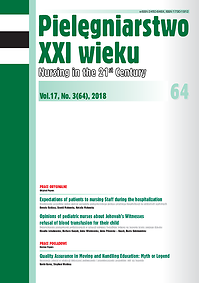Physical activity of adolescents in the prevention of lifestyle diseases
DOI:
https://doi.org/10.2478/pielxxiw-2018-0025Keywords:
physical activity, adolescents, prevention of lifestyle diseasesAbstract
PHYSICAL ACTIVITY OF ADOLESCENTS IN THE PREVENTION OF LIFESTYLE DISEASES
Introduction. The physical activity of adolescents forms an important aspect of their normal development and the prevention of lifestyle diseases.
Aim. The aim of this paper is to evaluate the effect of physical activity of adolescents on the prevention of lifestyle diseases.
Material and method. The study covered a sample of 135 students from a secondary school in Zamość, Poland, was conducted in 2016, and used the diagnostic survey method. The research tool was the International Physical Activity Questionnaire (IPAQ) in its Polish adaptation (the abridged version) and a survey questionnaire developed by the authors.
Results. More than half of the respondents (63.70%) engaged in sports activities in addition to PE classes at school, usually choosing team sports. According to the IPAQ key, 40.74% of the students demonstrated a high level of physical activity, 39.26% a moderate level, and 20% an insufficient level. The students were of the view that regular physical activity is of substantial importance in the prevention of diabetes (12.66% of the boys; 28.57% of the girls; p=0.037). At the same time, it was found not to have any major effect on the prevention of obesity, cancers, diseases of the musculoskeletal system or cardiovascular diseases.
Conclusions. The majority of the students declared that they regularly engaged in physical activity outside of school. According to the IPAQ assessment, the physical activity of adolescents remains at a high level, which may be considered as a positive indicator for the prevention of lifestyle diseases.
References
1. Ponczek D, Olszowy I. Styl życia młodzieży i jego wpływ na zdrowie. Probl. Hig. Epidemiol. 2012; 2 (93): 260-268.
2. Althoff T, Sosič R, Hicks JL, et al. Large-scale physical activity data reveal worldwide activity inequality. Nature; 2017; doi:10.1038/nature23018
3. Mazur J, Małkowska-Szkutnik A. red. Wyniki badań HBSC 2010. Raport Techniczny. Warszawa: Instytut Matki i Dziecka; 2011: 109-121.
4. Brzeźniak H, Mroczek B, Kotwas A, i wsp. Analiza wybranych zachowań zdrowotnych oraz samooceny masy ciała szczecińskich gimnazjalistów. Fam. Med. Prim. Care Rev. 2015;17 (2): 82-85.
5. Dziubak M, Dziedzic M, Mierzwa A. Wiedza licealistów o wpływie stylu życia na występowanie chorób układu krążenia i chorób nowotworowych a ich zachowania zdrowotne. Prz. Med. Uniwer. Rzesz. Inst. Leków w Warszawie. 2011; 2: 224-238.
6. Biernat E, Stupnicki R, Gajewski AK. Międzynarodowy Kwestionariusz Aktywności Fizycznej (IPAQ) – wersja polska. Wychow. Fiz. i Sport 2007; 51 (1): 47-54.
7. Kułaga Z, Różdżyńska A, Palczewska I, i wsp. Siatki centylowe wysokości, masy ciała i wskaźnika masy ciała dzieci i młodzieży w Polsce – wyniki badania OLAF. Stand. Med. Pediatr. 2010; 7: 690-700.
8. Currie C, Zanotti C, Morgan A, et al. Social determinants of health and well-being among young people. Health Behaviour in School-Aged Children (HBSC) Study: international report from the 2009/2010 survey. Copenhagen: WHO Regional Office for Europe, 2012.
9. Wojtyła A, Biliński P, Bojar I, Wojtyła K. Aktywność fizyczna młodzieży gimnazjalnej w Polsce. Probl. Hig. Epidemiol. 2011; 2 (92): 335-342.
10. Grabińska M, Barczykowska E, Bordon M, i wsp. Wybrane aspekty stylu życia młodzieży gimnazjalnej. J. Health Sci. 2014; 4 (11): 309-327.
11. Owoc A, Maliszewska D, Bojar I. Ocena poziomu wiedzy młodzieży warszawskich szkół średnich na temat wybranych czynników ryzyka chorób układu krążenia. Med. Og. 2010; 45 (16): 582-594.
12. Marcysiak M, Zagroba M, Ostrowska B, i wsp. Aktywność fizyczna a zachowania żywieniowe dzieci i młodzieży powiatu ciechanowskiego. Probl. Pielęg. 2010; 18(2): 176-183.
13. Nawrocka M, Kujawska-Łuczak M, Bogdański P, i wsp. Ocena sposobu odżywiania i aktywności fizycznej wśród uczniów szkół ponadpodstawowych. Endokr. Otyłość i Zab. Przem. Mat. 2010; 6 (1): 8-17.
Published
Issue
Section
License
Copyright (c) 2018 Authors

This work is licensed under a Creative Commons Attribution-NonCommercial-NoDerivatives 3.0 Unported License.




